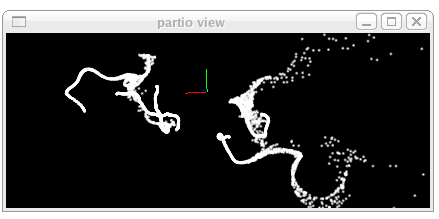Usage Examples
Tools
One handy thing that the Partio provides is simple command line tools to manipulate and example particle data. For example you can get information on a particle file of any type by using "partinfo".
$ partinfo test.bgeo Number of particles: 9998 Type Count Name ---- ----- ---- VECTOR 3 position VECTOR 3 v INT 1 id INT 1 parent FLOAT 3 Cd particle 0 position 0.536567 1.17344 0.523275 particle 1 position 0.495414 0.913424 0.434151You can also view particles in a simple standalone (and very quick to load) particle viewer
$ partview test.bgeo

$ partconv test.bgeo test.ptc
C++ API
In C++ particle files can be created and added in a similar way. We have an iterator that allows quick iteration through data in the same way regardless of the internal format. As an example of computing the average position of all particles in a set.
// open file
ParticleData* simple=Partio::read("test.pdb");
if(!simple) die("failed to open test.pdb");
// prepare iteration
auto iterator=simple->begin(), end=simple->end();
ParticleAttribute posAttr;
if(!simple->attributeInfo("position",attr) || attr.type != VECTOR || attr.count != 3)
die("failed to get position as vector of size 3");
ParticleAccessor posAcc;
iterator.addAccessor(posAcc);
// compute sum
float avg[3] = {0,0,0};
int cnt=0;
for (auto it=simple->begin(); it!=simple->end(); ++it) {
float* data = posAcc.raw<float>(it);
for(int k=0; k < 3; k++) {
avg[k] += data[k];
}
cnt++;
}
for (int k=0; k < 3; k++) {
data[k] /= cnt;
}
simple->release();
Python API
Often particles need to be manipulated after the fact to have additional or fewer attributes. To compute aggregate statistics on a file etc. The python API to partio allows you to do this very quickly. The following code increases the radii on particles by 2, if within a distance of one of the origin.
#!/bin/env python
import partio
filenameIn,filenameOut=sys.argv[1:]
p=partio.read(filenameIn)
pos,radius=p.attributeInfo("position"),p.attributeInfo("radius")
for i in p.numParticles():
if dist(p.get(pos)) <= 1:
p.set(i,radius,(p.get(i,radius)[0]*2,))
partio.write(filenameOut,p)